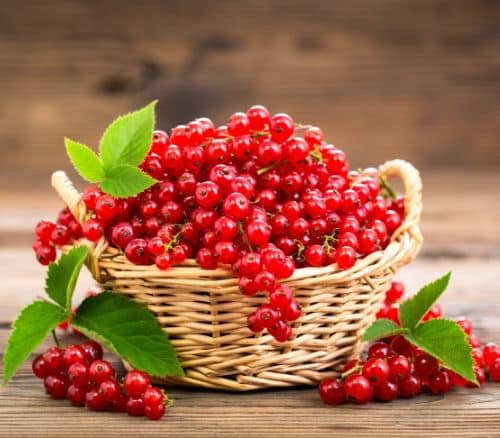Sweet and juicy fruits are nature’s candy. And it’s so easy to grow! Imagine walking through your garden, picking the ripest, freshest fruit from your own trees and bushes.
You don’t need an orchard, a dedicated allotment, or a greenhouse – fruit trees can fit in your borders and thrive in containers too. Many fruit bushes also love growing up against a sunny wall or fence.
If you’re really short of space, look for dwarf varieties that don’t grow too big but still produce plenty of fruit.
Top 10 easy fruit plants for beginners
How to plant soft fruit bushes
Soft fruit will grow in most soil types, but ideally, it should be rich and well-drained. However they don’t like heavy soils that get waterlogged, so dig in lots of organic matter if you have clay soil.
Dig over the area before planting to loosen the soil and add a handful of fertiliser.

Container-grown fruit bushes can be planted at any time. But I recommend trying bare-root bushes – they need to be planted in autumn or winter while they are dormant, but they are much cheaper to buy. Make sure to soak the roots before replanting – here’s my bare-root advice guide.
Always avoid putting new plants in too deep. This can smother the roots and kill the plant. Use the ‘soil mark’ on the stems as a guide.
Some of these plants need pruning immediately after planting. This is very important to help them survive the move and produce vigorous new growth – don’t skip it. And keep new plants well-watered in dry spells for the first few months until their root systems get established.
How to plant strawberries

Plant strawberries in late summer and early autumn, but make sure to choose a spot where they haven’t grown for a few years. Pick somewhere warm and sunny for sweet, ripe fruits.
Dig a hole wide and deep enough to hold the roots and set the crown level with the soil surface. Backfill with soil and water. Space plants 45cm apart. Replace strawberry plants every few years and choose a new location for them.
Alternatively, here is how to plant a terracotta strawberry pot.
How to plant raspberries

There are two types of raspberries: floricane (summer-fruiting) and primocane (autumn-fruiting). Floricanes produce all of their fruit in one go in early summer. Primocanes produce a slower crop from high summer right up to the first frosts.
Choose a sheltered spot in full sun or partial shade and dig a hole wide enough for the rootball. Plant and backfill with soil, spacing the canes 45cm apart. Water well and keep watered during dry spells or the canes may die.
Regular canes need pruning back after planting to 25cm from the ground. The only exception are some types of summer-fruiting canes, sold as ‘long’ canes. These are prepared to fruit the first year after planting and should not be pruned.
How to plant blackberries

Blackberries are ramblers and need something to grow up or over. Put in trellis or attach horizontal wires to a wall or fence panel. Choose a well-drained, sheltered spot in full sun or partial shade.
Dig a hole wide enough for the rootball and plant it just a little bit deeper than it was previously grown. Space plants at least 2m apart and water well. After planting, cut back all stems to 25cm from the ground to promote vigorous new growth.
How to plant currants

Blackcurrants, redcurrants and whitecurrants are all great fruit bushes for the garden. Choose a very sheltered spot as they do not like strong winds or late-spring frosts, which damage new leaves.
Plant into moisture-retentive soil and water well. Space plants 1.2m apart. After planting, cut the branches of blackcurrants back to 10cm above ground level. Cut back the branches of red and white currants by half.
How to plant blueberries

Blueberries differ from other soft fruits because they need acidic soil. They will struggle in regular garden soil, so grow them in containers filled with ericaceous compost.
Choose a container that has plenty of room for the rootball and plant to the same depth. Water well with rainwater, not tap water, which can be too alkaline for acid-loving plants.
How to plant gooseberries

Gooseberries need deep soil that doesn’t get too dry in summer. Choose a moisture-retentive spot in full sun or partial shade. Plant the canes just slightly deeper than they were previously grown and water well. After planting, prune back the canes by half.


What do you suggest to stop wildlife decimating our haul? Over the past couple of years we keep losing huge percentages of our fruit to wildlife. In the first few years of having our allotment we could grow whatever we wanted and only a little bit would be eaten by the local wildlife, but the last couple of seasons have been outrageous. Will a fruit cage give us the protection that we need? I’ve seen a load of differing styles and sizes https://www.harrodhorticultural.com/fruit-cages-tcid15.html#, if I’m going to go for it I might put the entire allotment space in a cage then everything gets an extra layer of protection.
Hi Tommy – what sort of wildlife is causing problems at your allotment? Fruit cages like that are certainly worth the money and are beneficial for keeping your plants protected. Thanks, Elli
Today, I went to the beach front with my children. I found a sea shell and gave
it to my 4 year old daughter and said “You can hear the ocean if you put this to your ear.”
She put the shell to her ear and screamed. There was a hermit crab inside and it pinched her ear.
She never wants to go back! LoL I know this is totally off topic but I had to tell someone!